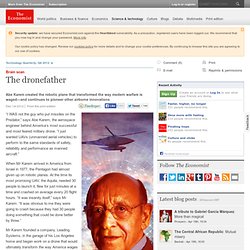

Drone Wars: Armed Unmanned Aerial Vehicles. On August 5, 2009, two Hellfire missiles fired from an American Predator drone crashed through the roof of a house in northwest Pakistan.

Lying on the roof of his father-in-law’s house was Baitullah Mehsud, the leader of the Pakistani Taliban. Along with Mehsud, the explosion killed his father-in-law, his mother-in-law, his wife, his uncle, a lieutenant and seven bodyguards. It took three days for mainstream news sources to confirm rumors of the Taliban leader’s death as the Taliban moved to prevent the news from leaking out. While the Pakistani newspaper Dawn ran the headline “Good Riddance, Killer Baitullah” in celebration of the death of the man believed responsible for the assassination of former Prime Minister Benazir Bhutto, Pakistanis typically condemn similar drone strikes due to the civilian casualties they cause.
In Mehsud’s case, it took sixteen strikes, fourteen months and between 207 and 321 additional deaths to finally kill him. Drones: A Photo History. VIDEO: Anti-drone protest in Pakistan sparks strong emotion. MANZAI, Pakistan — Anti-drone protesters tried to conquer barbed wire, ditches, police squads, soldiers and shipping containers blocking the road to reach South Waziristan, the planned destination of a march Imran Khan kicked off in Islamabad on Saturday. But Khan, the cricketer-turned-leader of his own political party, Movement for Justice, had decided not to visit South Waziristan after all. The army had reportedly warned him of possible attacks if he were to proceed. “It is our constitutional right to go everywhere in Pakistan.
Why aren't you giving us our rights? You are violating our laws. One container was pushed on its side, while another was pushed to the roadside. In Manzai, near the border of South Waziristan, protesters conquered perhaps the last blockade of soldiers and barbed wire before the protest fizzled out. “What does America have to do with our country?” The majority of protesters went to the nearby town of Tank, where Khan held a rally.
“I always drive slow,” he said. Attack of the Drones - USA. PREDATOR'S PROGRESS. Deadlier drones are coming. COLUMBIA, S.C. — Aerial drones are America's newest frontline weapon in an escalating global campaign against Islamic militants. And they could get a lot more dangerous in coming years as their underlying technology advances. Compared to today's fairly rudimentary Unmanned Aerial Vehicles (UAVs), the drones of the future will be faster and more heavily armed. They will also have better sensors plus more sophisticated computers allowing them to plan and execute attacks with less human participation. But military analysts and experts on the future of warfare fear these robotic drones could also wind up in the arsenals of more US agencies and foreign governments.
That, they add, raises the specter of a whole new kind of conflict which would essentially remove the human element — and human decision-making — from the theater of war. The prospect of even bloodier robot-waged warfare has some experts pleading for a ceasefire, or at least a pause in the pursuit of lethal technology. The future of drone technology. Reprieve press conference on drones. Brain scan: The dronefather. “I WAS not the guy who put missiles on the Predator,” says Abe Karem, the aerospace engineer behind America’s most successful and most feared military drone.

“I just wanted UAVs (unmanned aerial vehicles) to perform to the same standards of safety, reliability and performance as manned aircraft.” When Mr Karem arrived in America from Israel in 1977, the Pentagon had almost given up on robotic planes. At the time its most promising UAV, the Aquila, needed 30 people to launch it, flew for just minutes at a time and crashed on average every 20 flight hours. “It was insanity itself,” says Mr Karem. “It was obvious to me they were going to crash because they had 30 people doing something that could be done better by three.” Mr Karem founded a company, Leading Systems, in the garage of his Los Angeles home and began work on a drone that would ultimately transform the way America wages war.
It was almost inevitable that Mr Karem would become an aerospace engineer. Home-grown drones.